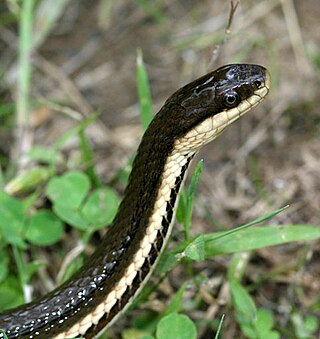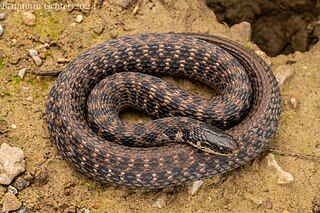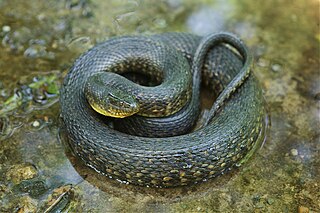
Rena humilis, known commonly as the western blind snake, the western slender blind snake, or the western threadsnake, is a species of snake in the family Leptotyphlopidae. The species is endemic to the southwestern United States and northern Mexico. Six subspecies are currently recognized, including the nominate subspecies described here.

Tropidoclonion is a genus of snake in the subfamily Natricinae of the family Colubridae. The genus is monotypic, containing the sole species Tropidoclonion lineatum, commonly known as the lined snake. The species is endemic to North America.

The long-nosed snake is a species of nonvenomous snake in the family Colubridae. The species is endemic to North America. It has two recognized subspecies. The other species in the genus were previously considered subspecies.

Nerodia is a genus of nonvenomous colubrid snakes commonly referred to as water snakes due to their aquatic behavior. The genus includes nine species, all native to North America. Five of the species have recognized subspecies.

The Trans-Pecos rat snake or Davis Mountain rat snake, is a species of medium to large, nonvenomous rat snake in the family Colubridae. Bogertophis subocularis is endemic to the Chihuahuan Desert.

Carphophis vermis is a species of small, nonvenomous colubrid snake native to the United States.

Nerodia rhombifer, commonly known as the diamondback water snake, is a species of nonvenomous natricine colubrid endemic to the central United States and northern Mexico. There are three recognized subspecies of N. rhombifer, including the nominotypical subspecies.
Roger Conant was an American herpetologist, author, educator and conservationist. He was Director Emeritus of the Philadelphia Zoo and adjunct professor at the University of New Mexico. He wrote one of the first comprehensive field guides for North American reptiles in 1958 entitled: A Field Guide to Reptiles and Amphibians of Eastern and Central North America, in the Peterson Field Guide series.

Regina is a genus of semiaquatic natricine colubrid snakes known as crayfish snakes, named after their primary choice of diet. The genus consists of two species which are found in the eastern and central United States.

The Texas scarlet snake is a species of nonvenomous snake in the family Colubridae. The species is endemic to the South Central United States. It was previously considered a subspecies of Cemophora coccinea.

The Texas lyre snake is a species of mildly venomous, rear-fanged snake in the family Colubridae. The species is endemic to the southwestern United States and adjacent northern Mexico.

Nerodia paucimaculata, commonly known as the Concho water snake, is a species of mostly aquatic, nonvenomous snake in the family Colubridae. The species is endemic to Texas in the United States.

The banded water snake or southern water snake is a species of mostly aquatic, nonvenomous, colubrid snakes most commonly found in the Midwest, Southeastern United States.

Regina grahamii, commonly known as Graham's crayfish snake, is a species of nonvenomous semiaquatic snake in the subfamily Natricinae of the family Colubridae. The species is endemic to the central United States.

The crayfish snake, also known commonly as the glossy crayfish snake, the glossy swampsnake, the glossy water snake, and the striped water snake, is a species of semiaquatic snake in the subfamily Natricinae of the family Colubridae. The species is endemic to the southeastern United States, and preys mainly on crayfish.

Kirtland's snake is a threatened or endangered North American species of nonvenomous snake of the subfamily Natricinae, of the family Colubridae. It is the only species in the genus Clonophis.

The green water snake is a common species of nonvenomous natricine snake endemic to the southeastern United States.

The brown water snake is a large species of nonvenomous natricine snake endemic to the southeastern United States. This snake is often one of the most abundant species of snakes found in rivers and streams of the southeastern United States, yet many aspects of its natural history are poorly known. Due to abundance and distribution throughout its biological range, this species could be used to investigate anthropogenic impacts on aquatic ecosystems by studying their movements.

The midland water snake, a subspecies of the northern water snake, is a nonvenomous natricine snake, which is endemic to North America.

The common watersnake is a species of large, nonvenomous, common snake in the family Colubridae. The species is native to North America. It is frequently mistaken for the venomous cottonmouth.




















